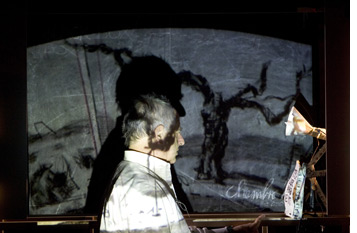William Kentridge
dal 28/10/2005 al 14/1/2006
Segnalato da
28/10/2005
William Kentridge
Deutsche Guggenheim, Berlin
Black Box / Chambre Noire

Curator Maria-Christina Villasenor, Associate Curator of Film and Media Arts, Guggenheim Museum, New York
The Deutsche Guggenheim presents in its exhibition space on Unter den Linden the commissioned multimedia-installation Black Box / Chambre Noire (2005) by the South African artist William Kentridge.
William Kentridge’s work reflects a deep engagement with issues of history and memory. Using vigorously reworked charcoal and pastel drawings as the primary basis for his films, he leaves highly visible pentimenti to suggest the work’s process and an ineffaceable past. Kentridge is also known for his theatrical productions for which he crafts layered, multimedia performances combining objects and their cast shadows, puppets and puppeteers, as well as his signature traces and erasures into moving image projections and set designs. In conceiving of a new art work, the artist took as a point of departure the commission’s originating site—broadly speaking, Germany. In addition to his focus on the history of Africa and South Africa, Kentridge has long exhibited an affinity to German art and culture. The artist’s most recent work, Black Box / Chambre Noire, was initially conceived while the artist was preparing to direct a major theatrical production of Mozart’s opera The Magic Flute, creating large-scale set designs and exploring actor staging and projections while utilizing a miniature stage maquette. That work on the Enlightenment-themed opera would lead to Black Box / Chambre Noire, which explores the darker implications of that era’s philosophical legacy, reflects the key process of reversal that so often takes center stage in the artist’s work.
In the work consisting of animated film, kinetic objects, drawings and a mechanical theater in miniature, Kentridge considers the term "black box" in three senses: a "black box" theater, a "chambre noire" as it relates to photography, and the "black box" flight data recorder used to record information in an airline disaster. Kentridge explores constructions of history and meaning, while examining the processes of grief, guilt, culpability, and expiation, and the shifting vantage points of political engagement and responsibility.
The development of visual technologies and the history of colonialism intersect in Black Box / Chambre Noire through Kentridge’s reflection on the history of the German colonial presence in Africa, particularly the German massacre of the Hereros in Southwest Africa (now Namibia) in 1904, an event considered by some historians to be the first genocide of the twentieth century.
This historical fact relates to William Kentridge’s South African identity, prompting him to question notions of agency and complicity, atonement and grief. In engaging issues of trauma and its aftermath, Kentridge explores the Freudian concept of "Trauerarbeit," or grief work, a labor which is ongoing, and which dovetails with the artist’s unrelenting and self-reflexive examination of the process of making meaning. In creating a work that reveals the motors of representation, Kentridge renders these means transparent, removing the veil of opacity behind which selective, subjective memories are crafted into grand narratives of history. The process-oriented, at times collaborative aspects of Kentridge’s work results in the complex and richly layered nature of Black Box / Chambre Noire.
German premiere of 9 Drawings for Projection & Journey to the Moon
December 2, 8 p.m./ December 4, 5 p.m.
Live music performance by the Archimia String Quartet and Vincenzo Pasquariello, piano, of Philip Miller's original soundtrack for Kentridge’s animated films 9 Drawings for Projection, created between 1989 and 2003, as well as his recent film Journey to the Moon, an homage to Georges Me'lie's.
A production of Art Logic, Johannesburg, and Change Performing Arts, Milan
Deutsche Guggenheim
Unter den Linden 13/15 10117 Berlin
Hours: Daily 11 a.m. to 8 p.m., Thursday 11 a.m. to 10 p.m.



